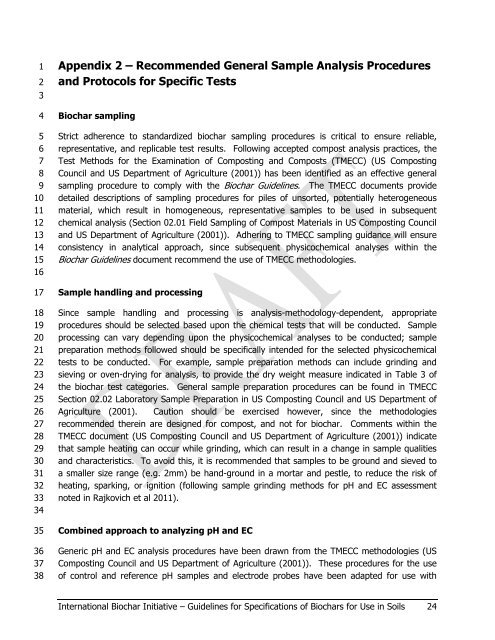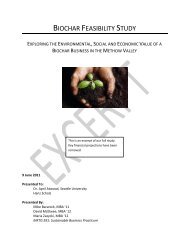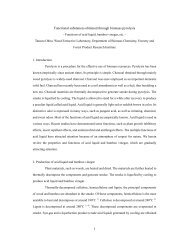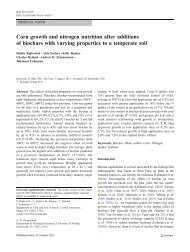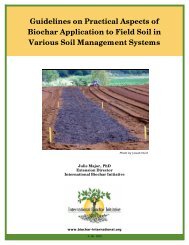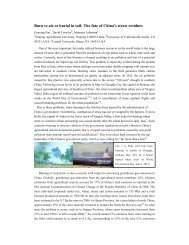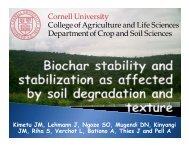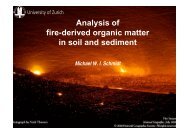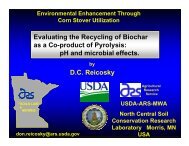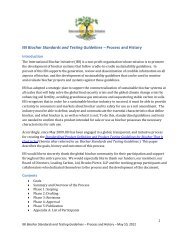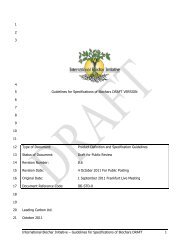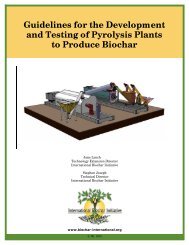Guidelines for Specifications of Biochars for Use in Soils FINAL ...
Guidelines for Specifications of Biochars for Use in Soils FINAL ...
Guidelines for Specifications of Biochars for Use in Soils FINAL ...
Create successful ePaper yourself
Turn your PDF publications into a flip-book with our unique Google optimized e-Paper software.
1234567891011121314151617181920212223242526272829303132333435363738Appendix 2 – Recommended General Sample Analysis Proceduresand Protocols <strong>for</strong> Specific TestsBiochar sampl<strong>in</strong>gStrict adherence to standardized biochar sampl<strong>in</strong>g procedures is critical to ensure reliable,representative, and replicable test results. Follow<strong>in</strong>g accepted compost analysis practices, theTest Methods <strong>for</strong> the Exam<strong>in</strong>ation <strong>of</strong> Compost<strong>in</strong>g and Composts (TMECC) (US Compost<strong>in</strong>gCouncil and US Department <strong>of</strong> Agriculture (2001)) has been identified as an effective generalsampl<strong>in</strong>g procedure to comply with the Biochar <strong>Guidel<strong>in</strong>es</strong>. The TMECC documents providedetailed descriptions <strong>of</strong> sampl<strong>in</strong>g procedures <strong>for</strong> piles <strong>of</strong> unsorted, potentially heterogeneousmaterial, which result <strong>in</strong> homogeneous, representative samples to be used <strong>in</strong> subsequentchemical analysis (Section 02.01 Field Sampl<strong>in</strong>g <strong>of</strong> Compost Materials <strong>in</strong> US Compost<strong>in</strong>g Counciland US Department <strong>of</strong> Agriculture (2001)). Adher<strong>in</strong>g to TMECC sampl<strong>in</strong>g guidance will ensureconsistency <strong>in</strong> analytical approach, s<strong>in</strong>ce subsequent physicochemical analyses with<strong>in</strong> theBiochar <strong>Guidel<strong>in</strong>es</strong> document recommend the use <strong>of</strong> TMECC methodologies.Sample handl<strong>in</strong>g and process<strong>in</strong>gS<strong>in</strong>ce sample handl<strong>in</strong>g and process<strong>in</strong>g is analysis-methodology-dependent, appropriateprocedures should be selected based upon the chemical tests that will be conducted. Sampleprocess<strong>in</strong>g can vary depend<strong>in</strong>g upon the physicochemical analyses to be conducted; samplepreparation methods followed should be specifically <strong>in</strong>tended <strong>for</strong> the selected physicochemicaltests to be conducted. For example, sample preparation methods can <strong>in</strong>clude gr<strong>in</strong>d<strong>in</strong>g andsiev<strong>in</strong>g or oven-dry<strong>in</strong>g <strong>for</strong> analysis, to provide the dry weight measure <strong>in</strong>dicated <strong>in</strong> Table 3 <strong>of</strong>the biochar test categories. General sample preparation procedures can be found <strong>in</strong> TMECCSection 02.02 Laboratory Sample Preparation <strong>in</strong> US Compost<strong>in</strong>g Council and US Department <strong>of</strong>Agriculture (2001). Caution should be exercised however, s<strong>in</strong>ce the methodologiesrecommended there<strong>in</strong> are designed <strong>for</strong> compost, and not <strong>for</strong> biochar. Comments with<strong>in</strong> theTMECC document (US Compost<strong>in</strong>g Council and US Department <strong>of</strong> Agriculture (2001)) <strong>in</strong>dicatethat sample heat<strong>in</strong>g can occur while gr<strong>in</strong>d<strong>in</strong>g, which can result <strong>in</strong> a change <strong>in</strong> sample qualitiesand characteristics. To avoid this, it is recommended that samples to be ground and sieved toa smaller size range (e.g. 2mm) be hand-ground <strong>in</strong> a mortar and pestle, to reduce the risk <strong>of</strong>heat<strong>in</strong>g, spark<strong>in</strong>g, or ignition (follow<strong>in</strong>g sample gr<strong>in</strong>d<strong>in</strong>g methods <strong>for</strong> pH and EC assessmentnoted <strong>in</strong> Rajkovich et al 2011).Comb<strong>in</strong>ed approach to analyz<strong>in</strong>g pH and ECGeneric pH and EC analysis procedures have been drawn from the TMECC methodologies (USCompost<strong>in</strong>g Council and US Department <strong>of</strong> Agriculture (2001)). These procedures <strong>for</strong> the use<strong>of</strong> control and reference pH samples and electrode probes have been adapted <strong>for</strong> use withInternational Biochar Initiative – <strong>Guidel<strong>in</strong>es</strong> <strong>for</strong> <strong>Specifications</strong> <strong>of</strong> <strong>Biochars</strong> <strong>for</strong> <strong>Use</strong> <strong>in</strong> <strong>Soils</strong> 24


